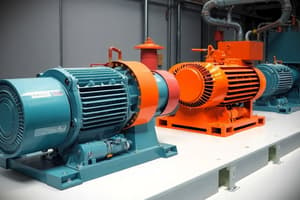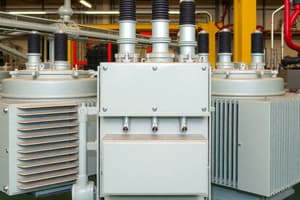Podcast
Questions and Answers
Which of these losses in electrical machines are directly related to the resistance of the windings?
Which of these losses in electrical machines are directly related to the resistance of the windings?
- Eddy current losses
- Hysteresis losses
- Stray losses
- Copper losses (correct)
Which type of electrical machine is primarily used for precise speed and position control?
Which type of electrical machine is primarily used for precise speed and position control?
- AC Induction Motor
- Stepper Motor
- DC Motor (correct)
- AC Synchronous Generator
What is the primary function of laminated iron cores in electrical machines?
What is the primary function of laminated iron cores in electrical machines?
- Reduce the magnetic field
- Increase the magnetic field
- Improve the conductivity of the core
- Minimize eddy current losses (correct)
What is the main reason for using different starting methods for different types of motors?
What is the main reason for using different starting methods for different types of motors?
Which of these is NOT a typical maintenance procedure for electrical machines?
Which of these is NOT a typical maintenance procedure for electrical machines?
Which type of electrical machine is typically used in power generation?
Which type of electrical machine is typically used in power generation?
What is the primary mechanism by which electrical machines convert energy?
What is the primary mechanism by which electrical machines convert energy?
Which of the following is NOT a key performance metric of an electrical machine?
Which of the following is NOT a key performance metric of an electrical machine?
What is the function of the stator in an electrical machine?
What is the function of the stator in an electrical machine?
What is the primary difference between synchronous and induction machines?
What is the primary difference between synchronous and induction machines?
In which type of electrical machine is the rotor speed directly proportional to the frequency of the supply?
In which type of electrical machine is the rotor speed directly proportional to the frequency of the supply?
Which type of electrical machine is commonly used in traction systems?
Which type of electrical machine is commonly used in traction systems?
What is the primary advantage of AC machines over DC machines?
What is the primary advantage of AC machines over DC machines?
Flashcards
Rotor
Rotor
The rotating part that interacts with a magnetic field.
Copper Losses
Copper Losses
Losses in electrical machines due to the resistance of windings.
Iron Losses
Iron Losses
Losses caused by eddy currents and hysteresis in the magnetic core.
Power Generation
Power Generation
Signup and view all the flashcards
Speed Control
Speed Control
Signup and view all the flashcards
Electrical Machines
Electrical Machines
Signup and view all the flashcards
DC Machines
DC Machines
Signup and view all the flashcards
AC Machines
AC Machines
Signup and view all the flashcards
Synchronous Machines
Synchronous Machines
Signup and view all the flashcards
Induction Machines
Induction Machines
Signup and view all the flashcards
Electromechanical Energy Conversion
Electromechanical Energy Conversion
Signup and view all the flashcards
Power in Machines
Power in Machines
Signup and view all the flashcards
Efficiency
Efficiency
Signup and view all the flashcards
Study Notes
Introduction to Electrical Machines
- Electrical machines convert electrical energy to mechanical energy (motors) or vice versa (generators).
- They are fundamental to modern power systems, including industrial processes, transportation, and domestic appliances.
- Key components include windings (conductors), magnetic fields, and mechanical parts (rotors and stators).
Types of Electrical Machines
- DC Machines:
- Operate on direct current (DC).
- Can act as motors or generators.
- Classified by their excitation (series, shunt, compound).
- Important in specialized applications such as traction and control systems.
- AC Machines:
- Operate on alternating current (AC).
- More prevalent in power generation and distribution due to advantages in transmission.
- Two main categories: synchronous and induction machines.
- Synchronous Machines:
- Rotor rotates at a speed proportional to the frequency of the supply.
- Used in power generation (generators) and some high-power applications (motors).
- Typically employ a DC excitation source.
- Induction Machines:
- Rotor speed is less than synchronous speed.
- Operate by induction of current in the rotor windings.
- Widely used in industrial drives and variable speed applications due to simple design and robustness.
- Synchronous Machines:
Principle of Operation
- Electromechanical Energy Conversion: Machines convert electrical energy to mechanical energy and vice versa through electromagnetic induction principles.
- Electromagnetic Forces: The interaction between magnetic fields and currents in windings creates mechanical forces.
- Torque Production: The torque produced is a critical factor in the machine's performance and applications.
Key Performance Metrics
- Power: Measured in watts or kilowatts, representing the energy conversion rate.
- Speed: Rotational speed, usually expressed in revolutions per minute (RPM).
- Torque: Rotational force, measured in Newton-meters (Nm). Critical for driving loads.
- Efficiency: The ratio of output power to input power, indicating machine losses.
- Voltage and Current: Parameters that define the electrical characteristics of the machine.
- Frequency: For AC machines, the frequency of the supply current.
Constructional Details
- Stator: The stationary part of the machine, usually carrying the windings and creating the magnetic field.
- Rotor: The rotating part, carrying windings or a mass to react to the magnetic field.
- Windings: Conductors arranged for efficient electrical and magnetic interactions.
- Magnetic Cores: Laminated iron cores to minimize eddy current losses.
- Bearings, Shaft, and Couplings: Mechanical components for support and connection to other machinery.
Losses in Electrical Machines
- Copper Losses (I²R Losses): Losses due to the resistance of the windings.
- Iron Losses: Losses due to eddy currents and hysteresis in the magnetic core.
- Mechanical Losses: Losses due to friction in bearings and windage.
- Stray Losses: Losses due to uncontrolled magnetic fluxes. Understanding and minimizing these losses is important for improving machine efficiency.
Applications
- Power Generation: Large-scale AC synchronous generators are crucial in power plants.
- Industrial Drives: Motors for various industrial processes, using AC induction or DC motors.
- Transportation: Traction motors in electric vehicles and trains.
- Household Appliances: Motors for fans, pumps, and other appliances.
- Control Systems: DC motors are used for precise speed and position control.
Operating characteristics and control
- Starting methods: Different methods for starting motors (induction, DC) to avoid high inrush currents.
- Load characteristics: Understanding the torque-speed relationship for various loads.
- Speed control: Techniques for adjusting the motor speed to match varying load requirements.
- Protection: Overcurrent and thermal protection to prevent damage to the machine.
Maintenance
- Regular maintenance procedures are essential to maintain the machine's performance and lifespan.
- Inspection for wear and tear, and lubrication of moving parts are critical steps.
- Monitoring of temperatures and current levels is vital for early fault detection.
Studying That Suits You
Use AI to generate personalized quizzes and flashcards to suit your learning preferences.
Description
This quiz covers the fundamentals of electrical machines, exploring the conversion of electrical to mechanical energy and vice versa. It highlights the components, types, and applications of both DC and AC machines, including key concepts like synchronous and induction machines. Ideal for students studying electrical engineering.




